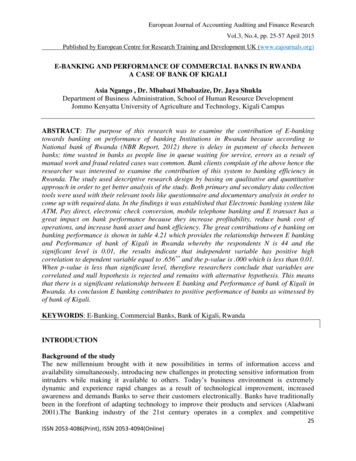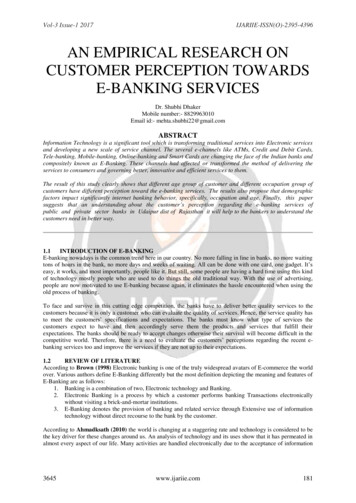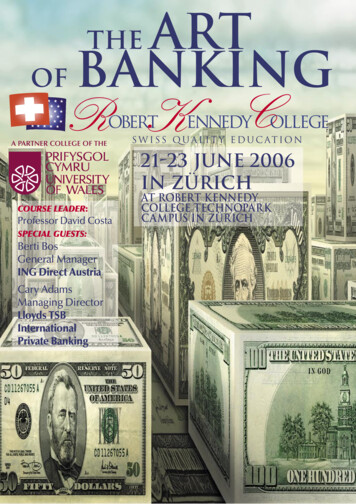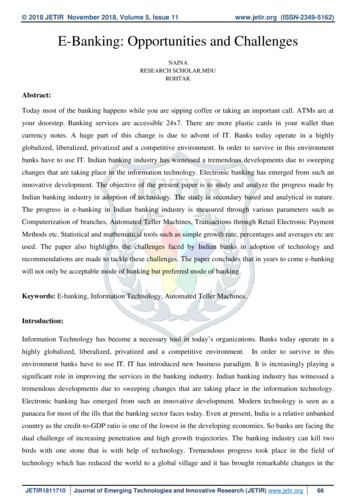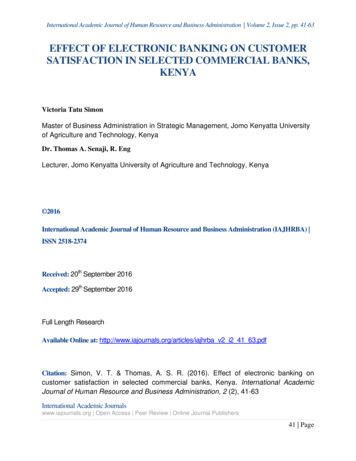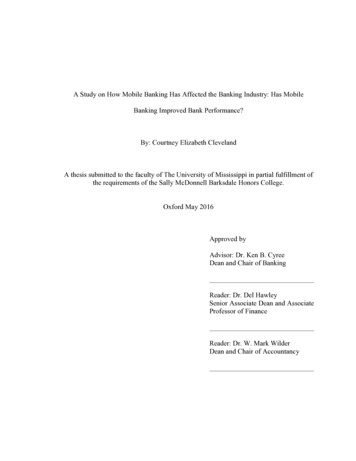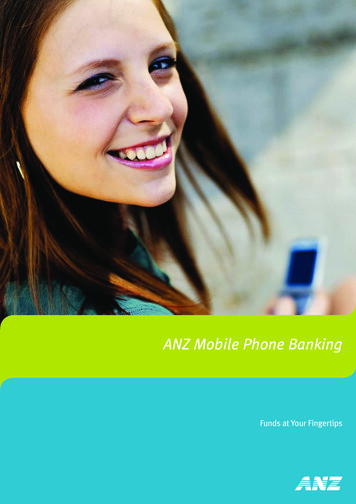
Transcription
International Journal of Business, Humanities and TechnologyVol. 8, No. 4, December 2018doi:10.30845/ijbht.v8n4p4E-Banking and Service Delivery in Eco Bank Nigeria a Comparative AnalysisOtokpaOgenyi & Okpe, Isa. J.Ph.D.Department of EconomicsBenue State UniversityMakurdiAbstractThis study investigates E-banking and service delivery at Ecobank Nigeria in Benue State. A purposive samplingtechnique was employed to identify specific Users and Non-users of E-banking facilities. The respondents in eachgroup were randomly selected to avoid selection bias. Questionnaire and Oral interviews were used to collectdata for this study. A Sample of 400 Users of E-banking and 395 Non-user of e-banking products of EcobankNigeria was selected. Descriptive tools such as tables, percentages, charts, ratios, and averages were used.Statistical analysis, specifically the Kolmogorov-Smirnov test, Shapiro-Wilk, and Satter Thwaite-Welch t-testswere used. The results showed that there is a significant difference between the time spent on the queue by Usersand Non-users of E-banking at Ecobank Nigeria in Benue State in favor of the Users of E-banking (3.287 minutesfor Users and 33.07 minutes for Non-users). The study also revealed that there is a significant difference in thefinancial cost for using E-banking (N80.51) and banking hall services (N274.81) also in favor of the Users of Ebanking. The major problem faced in the use of E-banking as indicated by the users is network failure while theNon-users spend longer time (33.07 minutes) on queue to obtain financial services. The study, therefore,recommended that banks should invest more on Information and Communication Technology (ICT); in higherversion of radio-wave like fiber and subscribe to Internet Service Provider (ISP) with higher bandwidth to enablethem to render the expected service to the end-users instead of relying heavily on other internet networkproviders.Keywords: Ecobank, E-banking, service delivery, Users and Non-usersIntroductionThe emergence and growth of E-banking have been made possible following the revolution and rapiddevelopment in the Information and Communication Technology (ICT). This has had a profound impact on thebanking industry and the wider financial sector in Nigeria over time. Berger (2003) opined that its utilization hasincreased in the service industry particularly the banking sector as it created an enabling environment for banks todifferentiate their products and services to meet the challenges of market competition among other things.Baraghani (2008) reaffirmed that banks have found that they have to constantly innovate and update to retain theirdemanding and descending customers and to provide convenient, reliable and expedient services. The E-bankinghas now become a tool that facilitates the bank’s operations, business strategies and effective customer servicesdelivery. Owing to this foregoing, Ranee (2008) asserted that the recent “ICT revolution” has exerted a farreaching impact on economies in general, and the financial services industry in particular. Driven by the challengeto expand and capture a larger share of the banking market, almost all banks in Nigeria have implemented a morerevolutionary approach to deliver their banking services via the internet medium (Internet Banking).In Benue state, there are sixteen (16) commercial bank branches. These banks provide E-banking facilities andbanking hall services. The E-banking products offered by these banks in Benue State are the same in servicesprovided but differ only in nomenclature such as First bank ATM, Zenith bank ATM, Access bank Mobile Moneyetc. However, the number of ATM terminals among the banks differs in quantity. There are one hundred andforty-five (145) functional ATM terminals in Benue State; of these numbers, Ecobank has seventeen (17) which isabout 12% of the total number of functional ATM terminals in Benue state. These bank’s ATM terminals areinterconnected with aid of the internet through inter-switch company thereby making it possible for other bank’scustomers to carry out financial transactions on another bank’s ATM without attracting extra financial cost to theusers.30
ISSN 2162-1357 (Print), 2162-1381 (Online) Center for Promoting Ideas, USAwww.ijbhtnet.comAnother E-banking platform is Ecobank Mobile Money. This is a phone (mobile phone) based business developedto expand activities in the area of mobile financial services. It is operational anywhere provided there is theavailability of GSM network. It is interesting to know that Ecobank Mobile Money services can also be access bynon-customers of Ecobank through the bank’s mobile money agents. All these innovations are geared towardsefficient service delivery in the services industry especially the banking sub-sector, however, a good number ofcustomers up till now prefer using the banking hall services instead of the alternative electronic channels madeavailable in the bank. Thus, this study seeks to unravel how efficient is E-banking to service delivery at EcobankNigeria in Benue State.Conceptual FrameworkOne of the determinants of E-banking and service delivery by Ecobank Nigeria is Time Spent on the Queue. It isassumed in this study that service is delivered if the time spent on the queue is 10 minutes or below. The bestpractice in Ecobank Nigeria specifies 5minutes turnaround time for cash deposits and withdrawals and 8 minutesfor assessing bank drafts. However, considering the speed and fluctuation of internet services, 10minutes isassumed in this work. Financial Cost involves the cost associated with the use of banking hall services or Ebanking facilities (ATM) as regards transportation cost and the cost of services received. It is assumed thatservices are delivered if the cost incurred for accessing bank services is N100 and below. The Number offunctional ATM terminals available for use is also another important factor. These include both Ecobank andother bank’s ATMs. ATM functionality is defined in terms of ability to perform any of the services such asbalance inquiry, cash withdrawal, phone recharge, and fund transfers. In this study, service is delivered if 50% ofthe available ATM terminals are able to perform any of the above-mentioned services. Average Network up Timeis also considered: This has to do with the availability of internet network connectivity on ATM terminals, GSMhandset for the purpose of Mobile Money transactions and in the banking hall. Services can be said to bedelivered if only there is 80% the availability of internet network of the time customers goes to use the ATMterminals though, the best practice of Ecobank Nigeria is 99.99%.Empirical ReviewIn order to find out the response level of the elderly in terms of technology adaptation in the banking sectorZeithaml and Gilly (1987) used questionnaires on 2500 elderly respondents and observed that the elders are moreresponsive to the use of scanners electronic fund transfer but are averse to the use of automatic teller machinewhile Marshall and Heskop (1988) used Cronbach’s alpha to ascertain the demographic factors that influence theuse of ATM. Demographic factors such as higher education levels and employment status were positively relatedto the usage of ATMs while age was negatively related to the adoption of ATMs.Leblanc (1990) used Chi-squareto find out consumer motivation for using ATMs and discovered that the use of technology in banking sectorimproved service quality, with little security risk and it also fulfilled their need for simple and fast transactions. Itwas found out that non-users of ATMs preferred interacting with human tellers and perceived ATM usage to becomplex and risky. Lewis (1991) found that customers mainly used ATMs for withdrawal of cash and obtainingaccount balances. But also found that customers are mainly concerned about their personal safety, lack of privacyand operational problems such as machine being regularly out of cash or out of order, and cards getting stuck in it.Rugimbana and Iversen (1994) found that ATM customers mostly used ATM for cash withdrawal and conductedless than 50% of their transactions through it. The study concluded that most users perceived ATMs to beconvenient cash dispensers, while the non-users preferred contact with human tellers and hence had a need forpersonal service. Sathye (1999) examined the factors affecting the adoption of Internet banking by Australianconsumers. Descriptive analyses were used in examining the ATM variables while ANOVA was used todetermine the differences in perception of customers. The study found that security concerns and lack ofawareness about Internet banking and its benefits stand out as being the obstacles to the adoption of internetbanking in Australia.Polatogulu and Ekin (2001) conducted an exploratory study of consumer acceptance of internet banking servicesin a Turkish bank. Frequencies and percentages, as well as multiple regression analyses, were used and hinted thatinternet banking reduces the operational cost to the bank and enhances customer satisfaction and retention.Bello (2005) investigated the impact of E-banking on customer satisfaction in Nigeria with a major focus on FirstBank Nigeria Plc, Zenith Bank Plc and Guaranty Trust Bank Plc in Lagos, Port Harcourt, and Kaduna. The studyused primary data and the result was presented using descriptive statistics and analyzed the same using Chi31
International Journal of Business, Humanities and TechnologyVol. 8, No. 4, December 2018doi:10.30845/ijbht.v8n4p4square. The study found out that many banks’ customers in Nigeria are fully aware of the positive developmentsin information technology and telecommunications. Malhotra and Singh (2006) examined the impact of internetbanking on bank performance in India with a major focus on the users and non- users of internet facility. Aunivariate statistical analysis was used and the findings revealed that internet banks have better accountingefficiency ratios and higher returns on equity and returns on assets than non-Internet banks. However, the multipleregression results reveal that the profitability and offering of Internet banking do not have any significantassociation.Arnaboldi and Claeys (2008) compared the performance of ‘click and mortar’ model of banking with internetbanking across countries in Europe such as Finland, Spain, Italy, and the UK over the period of 1995-2004. Afuzzy cluster analysis on the performance of banks shows that internet banks are hard to distinguish from banksthat follow a click and mortar strategy. The study also found that the strategy of banking groups to incorporateinternet banks reflects some competitive edge that these banks have in their business models and extensivetechnological innovation boosts internet banking.Osabuohien (2008) used cross tabulation to assess the efficacy of ICT in the banking sector in Nigeria. Primarydata were employed to generate information for the study and the result shows that bankers’ age, educationalqualification, computer literacy and type of ICT gadgets influence banks’ degree of ICT usage, while ICT impactssignificantly on the speed of banking operations, productivity, and profitability. Auta (2010) used Kaiser-MeyarOlkin (KMO) approach and Barlett’s Test of Sphericity to assess the impact of E-banking on 25 commercial bankcustomers and staff. The result shows that E-banking has played a significant role in the Nigerian banking sectorwhile Antony (2011) used the Chi-square test which revealed that E-transaction has an overwhelming impact oncustomer satisfaction. In terms of human resource performance and customer satisfaction, Olanipekun, Brimah,and Ajagbe (2013)used a Chi-square test on fifty respondents. The findings revealed that electronic banking hasimpacted positively on the bank's human resource performance while Abaenewe (2013) revealed a mixed resultabout the impact of e-banking on Returns on Equity (ROE) of Nigerian banks.Okiro and Ndungu (2013) assessed the impact of mobile and internet-banking on the performance of financialinstitutions in Kenya using descriptive statistics. The study observed that the most prevalent internet bankingservice is balance inquiry and cash withdrawal while the least is online bill payment and purchasing commodities.In Zimbabwe Muzividzi, Mbizi and Mukwazhe(2013) used questionnaires and interview to elicit informationfrom respondents and hinted that internet banking is convenient and cheaper to use than the analogue type ofbanking and saves time. They observed that security played an important factor in the adoption and non-adoptionof internet banking platform while in Malaysia, Hong, Teh, Vinayan, Soh, Khan, and Ong (2013) revealed thatcomplexity, security and customer experience were the influencing factors of Internet banking services in thearea. Similarly, Ling, Fern, Boon, and Huat, (2015) used questionnaires on 200 participants in Malacca, Malaysiaand found out that web design and content, security and privacy, convenience and speed greatly influenceconsumer satisfaction in the study area.Ogunlowore and Oladele (2014) investigated the problem of internet banking on customer satisfaction in GTB inLagos on 100 respondents. Using ratios and chi-squares the findings show the problems faced are the poorinfrastructural facility, high illiteracy rate, poor regulation of e-banking structure as well as high cost and chargesof text messages. Mohammed, Aminul and Lakkhan (2015)used regression, factor analysis, and reliability test toascertain internet satisfaction with regard to ATM and found that cost of service of ATM, ATM network, security,location and withdrawal limit play prominent role in customer satisfaction in Dhaka city, Bangladesh whileSailaja& Thamodaran (2016) looked at the security of ATM facilities and observed a tripartite significantrelationship between E-banking, service delivery, and cost effectiveness but observed that there is a rise in ATMcrime in Indian.Theoretical FrameworkThe consumer acceptance of technology theory has been adopted as a theoretical framework for the researchwork. This theory is considered relevant in explaining bank’s services delivery to users through E-bankingbecause it takes into consideration the perceived usefulness of technology innovation which in this case is Ebanking as well as the relative advantage of the new technology (E-banking) in relation to other alternatives.These key aspects of the theory form the basis with which users can evaluate the services delivered by the bank.32
ISSN 2162-1357 (Print), 2162-1381 (Online) Center for Promoting Ideas, USAwww.ijbhtnet.comThe aspect of the relative advantage as theorized by the consumer acceptance model states that individuals aremore likely to adopt innovations that have perceived advantages than they are to buy products which have little orno additional benefits over the alternatives. As described by Rogers (2003), relative advantage means that theinnovation is believed by the adopter to be superior in some way to what it is intended to supersede. This goesthat the services rendered by banks through E-banking are more effective as compared to the previous analogbanking which is the reason for users to adopt and accept the innovation in banking technology (E-banking)MethodologyThe survey design was employed in this study. The data were collected using questionnaires. The studyemployed a purposive sampling technique to elicit the desired information from Users and Non-users of the Ebanking facilities. The data were analyzed using descriptive and inferential statistics such astables, percentages,charts, ratios, and averages while the Kolmogorov-Smirnov test, Shapiro-Wilk test, and Satterthwaite-Welch testwere used.A pre-survey report reveals that there are five branches of Ecobank in Benue state. The breakdown of thepopulation of the branches is stated in table 1. Makurdi has a total customer base on 86,923 with 67,254 users ofE-banking and 19,669 on non-users. Otukpo has a customer base of 30,000 with 21,000 and 9,000 users and nonusers of E-banking products while Gboko branch has a customer base of 25,000 out of which 18,750 users and6,250 non-user of banking products. A total customer base of 141, 923 were observed in the three branches madeup of 107,004 users and 34,919 non-users of the products.Table 1: Users and Non-Users of Ecobank E-Banking ProductsBRANCHCUSTOMER BASEUSERS OF S86,92319,669Makurdi 92334,919Source: Ecobank, 2014.The sample size for each branch was determined using Yameni (1967) sample size determination. Therefore, asample of 400 users of E-banking was selected while 395 for non-users were selected. Therefore a total of 795were selected for both users and non-users. However, a total of 378 representing 94.5% were retrieved from theUsers and 322 representing 82% were retrieved from the Non-users of E-banking at Ecobank Nigeria in BenueState.Table 2: Descriptive Statistics for Users and Non-users on Financial Cost.UsersNon-usersFinancial Cost (N)Financial Cost 0250Maximum100.00350Standard .12Jacque-Bera58.5944.70Source: Author’s computation using E-views.Table 2 shows the descriptive statistics on financial cost for Users and Non-users of E-banking at EcobankNigeria in Benue State. For the Users, the table reveals that the mean financial cost of N80.51 on transportationcost to ATM point and cost of transactions, with a minimum cost of N0.00 and a maximum cost of N100.00.The standard deviation of N41.85 was observed. This implies that variation in the financial cost from one User ofE-banking to another is approximately N41.85. The skewness and kurtosis indicate that the financial cost of usingE-banking at Ecobank Nigeria in Benue State is skewed to the left. However, it is not too extreme; hence thefinancial cost is normally distributed.33
International Journal of Business, Humanities and TechnologyVol. 8, No. 4, December 2018doi:10.30845/ijbht.v8n4p4For the Non-users, the mean financial cost of using banking hall is N267.39 with a minimum cost ofN250 and themaximum value of N350; while the variation in the cost from one Non-user to another (standard deviation) isN40.54. The skewness shows that the cost is positively skewed, while the kurtosis shows that the cost is not overpeaked. The difference in the mean financial cost for Users and Non-users is N186.88 in favor of Users of Ebanking.The Jacque-Bera values of 58.59 and 44.70 with corresponding probabilities of 0.0000 and 0.0000 (less than 0.05critical level) for the financial cost of using E-banking and Banking hall respectively, indicated that the data usedfor the study is normally distributed and thus estimates from it are expected to be unbiased and reliable.Table 3: Descriptive Statistics for Users and Non-users on Time SpentUsersTime Spent (in minutes)Non-usersTime Spent (in mum10.0060.00Standard 0Jacque Bera295.9328.80Source: Author’s Computation using E-views.Table 3shows the time spent on the queue for Users and Non-users of E-banking at Ecobank Nigeria in BenueState. For Users, the table reveals a mean time spent of 3 minutes and 24 seconds, with a minimum time spent of1.00 minute and a maximum of 10 minutes. A Standard Deviation (SD) of 2 minutes was observed. Theskewnessof 2 minutes and kurtosis of 4.11 minutes which is relatively higher than the conventional value of 3thisshows that the time used on the queue is relatively high. For Non-users, the mean time spent is 36minutes and 31seconds with a minimum value of 4 minutes and a maximum value of 60 minutes. The standard deviation whichmeasures the variation of time spent by one Non-user and the other is 15 minutes. The difference in the mean timespent by Users (3 minutes and 24 seconds) and Non-users (36 minutes and 31 seconds) of E-banking is 33minutesand 12 seconds. The Jacque-Bera values of 295.93 and 28.80 with corresponding probabilities of 0.0000 and0.0000 (less than 0.05 critical level) for the time cost (in minutes) of using E-banking and for the time cost (inminutes) of using banking hall respectively indicated that, the data used for the study is normally distributed andthus estimates from it are expected to be unbiased and reliable.Table 4: The Number of Functional ATM Terminals at Ecobank Nigeria in Benue State.Branches of EcobankNumber of ATMNumber of Functional ATMsOld Otukpo Road, Makurdi65OgiriOkoh Road, Makurdi44Gboko Road, Makurdi33Gboko Town22Otukpo Town22Total1716Source: Ecobank Newsletter, 2014.Table 4 shows that there are 17 ATMs of Ecobank Nigeria across Benue State of which 16 ATM terminals arefunctional; representing 94.12% of the total available ATM terminals in the state. The implication is that only5.88% of the total ATM terminals are not functional. This implies that there are 16 outlets in addition to otherbank’s 128 ATM terminals as at 2014 to access cash by Users of E-banking as compared to just 5 outlets(Ecobank Nigeria branches) available for use by the Non-users of E-banking.This makes cash easily accessible and at any time as compared to 5 branches of Ecobank Nigeria in Benue Statethat only operates within the official opening days and hours. Furthermore, the Users were asked whether theyhave access to other banks’ ATM terminals. Their responses are presented in Table 5.34
ISSN 2162-1357 (Print), 2162-1381 (Online) Center for Promoting Ideas, USAwww.ijbhtnet.comTable 5: Users Access to other banks’ ATM Terminals.ResponsesFrequencyPercentageHave Access378100.00Do not have Access00Total378100.00Source: Field Survey, 2014.Table 5 shows that all the users of ATM at Ecobank have indicated that they have access to other banks’ ATMterminals. The implication is that accessibility to and usage of E-banking is not a challenge since they can easilyaccess cash at any time.Table 6: Number of Functional ATM Terminals of other Banks Accessible by Users of E-Banking at Ecobank inBenue State.Number of ATM 0 and above8221.70Total378100.00Source: Field Survey, 2014.Table 6 shows the number of functional ATM terminals of other banks accessible to users of E-banking atEcobank. It shows that 53.2% of Users of E-banking at Ecobank Nigeria in Benue State have access to 1-4 ATMterminals of other banks in addition to the Ecobank ATMs; while 25.1% of Users have access to 5-9 ATMterminals in addition to Ecobank ATMs and 21.7% have access to 10 and above ATMs of other banks in additionto Ecobank’s ATMs. This suggests that accessibility to cash withdrawal channels via the ATM is sufficient tomeet their daily cash withdrawal needs to the limit allowed on ATM.Table 7: Average Uptime (in %) of Ecobank ATM and Mobile Money in Benue State.FrequencyPercentageAverage Uptime 100.00Source: Field Survey, 2014Table 7 was used to assess the average uptime of Ecobank ATMs and Mobile Money in the state. The table showsthat 18.8% of Users of E-banking at Ecobank Nigeria, have indicated there is an average uptime of 90-95% forboth ATM and Ecobank Mobile Money; and 46.3% of Users indicated that there is an average uptime of 96-98%for use and 34.9% of Users reported that there is 99-100% average uptime for ATM and Ecobank Mobile Moneyat Ecobank Nigeria in Benue State.Juxta posing these responses with the standard of the Service Level Agreement(SLA) of Ecobank which stipulates 95% average uptime of ATMs and Mobile Money as the minimum acceptableaverage uptime for all E-channels; it can be said that, E-banking platforms at Ecobank are readily available andfunctional for users to perform transactions. In assessing the efficiency of E-banking at Ecobank Nigeria in BenueState, tables 8 and 9 were presented on both users and non-users E-banking services.Table 8: Reasons for using ATM and Mobile Money at Ecobank Nigeria in Benue State by Users of EbankingReasonsFrequency PercentageConvenience & Time Saving28274.60Reduced Cost of Transportation9625.40Total378100Source: Field Survey, 2014.Table8 reveals the major reasons why customers of Ecobank Nigeria in Benue State prefer the usage of E-bankingto Hall banking, which includes convenience and time saving and reduced cost of transportation.35
International Journal of Business, Humanities and TechnologyVol. 8, No. 4, December 2018doi:10.30845/ijbht.v8n4p4Majority of the Users (that is, 74.60%) have indicated convenience and time saving as the core reason for using Ebanking while 25 % gave credence for the reduction in transportation cost. This suggests that using E-bankingplatforms will give them relative comfort and will reduce the time that otherwise would have been spent on thequeue in the banking hall. This finding corroborates the findings of Auta (2010) who found that E-bankingprovides transaction-related benefits like easy transfer of funds, less cost, and time savings.Table 9: Reasons for Using Hall Banking at Ecobank Nigeria in Benue State by Non-users.ReasonsFrequencyPercentageCash Withdrawal limit22546.58Fear of Fraudsters15632.30Network problem10221.12Total483*100.00Source: Field Survey,2014.*Respondents were allowed to give more than one challengeTable 9 shows that 225 customers representing 46.58% of Non-users have indicated the cash withdrawal limit as areason for using banking hall services instead of electronic channels; while 156 customers representing 32.30% ofthe Non-users advanced fear of fraudsters as a reason for preferring banking hall services to E-banking and lastly,102 customers representing 21.12% of the Non-users indicated network problem as reason for using banking hallservices instead of electronic channels.The table shows three major reasons why customers at Ecobank Nigeria in Benue State prefer hall banking to Ebanking. The major reason advanced by Non-users is the cash withdrawal limit that is imposed on the usage of Ebanking at Ecobank Nigeria. This may be because of the maximum daily limit of N150,000 withdrawal from theATM for customers ofEcobank, and the maximum of N1,000,000 transfer via Ecobank Mobile Money daily.Some of these customers (Non-users) are involved in cash based business transactions above thresholds ofEcobank Nigeria daily cash withdrawal and transfer limits.At this point, it becomes pertinent to assess the efficiency of these platforms in terms of time spent, cost involved,the volume of cash withdrawal and cash deposit and issuance of a bank draft.Figure 1: Time Spent on Queue For Users of ATM and Banking Hall at Ecobank Nigeria.Time Spent on queueNumber of respondents16014213014012010094100748040ATM users516027 3037Non ATM Users15200Less than 55 to 1011 to 1516 to 2021 andaboveAverage time spentFrom the figure, it can be seen that the longest time spent on the queue by Users of ATM is between 11 to 15minutes while the longest time spent on the queue by Non-users is 21 minutes and above. This shows that usingATM saves time than non-users of ATM spent in the banking hall.36
ISSN 2162-1357 (Print), 2162-1381 (Online) Center for Promoting Ideas, USAwww.ijbhtnet.comFurthermore, effectiveness was assessed in terms of transportation cost and the cost incurred in using a particularEcobank platform. The responses of Users and Non-users are presented in Table 10.Table 10: Transportation cost incurred by Users and Non-users in accessing the platforms.Cost ntageLess than 10017646.607824.20100-20013134.7010632.90201and above7118.8013842.90Total378100.00322100.00Source: Field Survey, 2014.It is assumed in this work that an average cost of intra-transport in Benue State is N50; however, it cost more inrelation to distance. From Table 10, 176 customers representing 46.60% of Users of E-banking facilities haveindicated that they spend less than N100 to access ATM terminals; while 78 customers representing 24.20% ofNon-users indicated that they spend less than N100 to access a bank branch. Also, the table shows that 131customers representing 34.70% of the Users of E-banking indicated that they spend between N100 to N200 ontransportation to access ATM terminals; while 106 customers representing 32.90% of the Non-users haveindicated that they spend between N100 to N200 to access an Ecobank branch. Furthermore, the table reveals that71 customers representing 18.80% of the Users of E-banking (ATM) said that they spend N201 and above ontransportation to access ATM terminals; while 138 customers representing 42.90% of the Non-users of E-bankingindicated that they spend N201 and above to access an Ecobank branch. The table reveals that majority (that is46.6%) of the users of E-banking indicated that they spend less than N100 for transportation to access ATMterminals. This suggests that ATMs are easily accessible relative to the bank branches; this is further supported bya higher percentage of Non-users (i.e 32.9%) for an amount ranging N100 -N200, and 42.9% for N201 and abovewho have indicated that they spend higher amounts for transport in accessing the banking halls for bankingservices. Table 11 solicits information on the cost for using any of the platforms such as ATM and Banking hallservices.Table 11: Responses on whether or not it Cost for Using the Platforms (E-banking and Banking Hall) byUsers and geFrequencyPercentageIt cost00322100.00It does not cost378100.0000Total378100.00322100.00Source: Field Survey, 2014.Table 11 shows 322 customers representing 100% of Non-users revealed that it cost them using the banking hallfor financial transactions while 378 customers representing 100% of the Users of E-banking facility (ATM) haveindicated
and Non-users of E-banking at Ecobank Nigeria in Benue State in favor of the Users of E-banking (3.287 minutes for Users and 33.07 minutes for Non-users). The study also revealed that there is a significant difference in the financial cost for using E-banking (N80.51) and banking hall services (N274.81) also in favor of the Users of E-banking .
